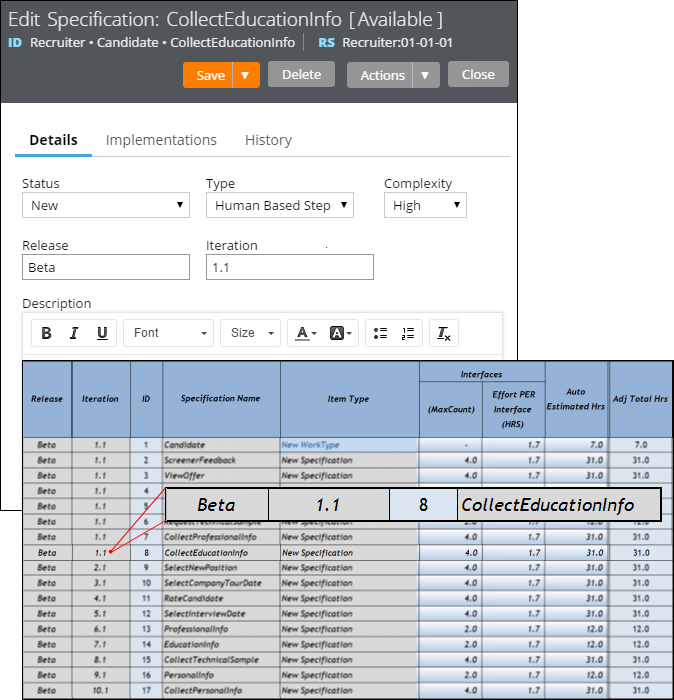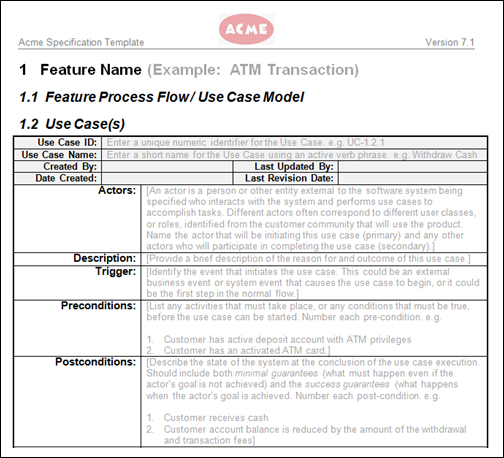Tracked changes persist between client sessions
Valid from Pega Version 7.1.7
The Microsoft Word native change tracking feature persists between client sessions for specifications. Enable this feature to facilitate collaborative reviews of your specifications with project stakeholders.
Inserting your specification updates as tracked changes allows you to:
- Provide visible markup to the next reviewer.
- Correlate edits to a specific user and time.
- Generate documents that include markup and comments.
Local settings, such as the colors you specify for markup, do not persist between clients.
For instructions on how to prevent markup and comments from appearing in generated documents, see Advanced options for editing specifications.
Add multiple attachments at once
Valid from Pega Version 7.1.7
You can now add more than one attachment to a requirement or specification at a time, without closing the Add/Edit Attachment modal dialog box. Use the traditional browse method to upload an attachment or drag and drop a local file, based on your needs. View and access your attachments from the Application Profile landing page, Requirement form, or Specification form.
Plan projects using release data
Valid from Pega Version 7.1.7
Requirements and specifications can now be mapped to a target release and iteration within a specific release. Populating these fields allows you to set and publish a release schedule through worksheets generated by the Sizing wizard. Access these fields from the Application Profile landing page or by opening any requirement or specification.

The Release and Iteration fields as they appear in a specification and a corresponding worksheet
The Sizing wizard incorporates values from the Release and Iteration fields for specifications only.
Specification type extended for decisioning users
Valid from Pega Version 7.1.7
Specifications now support a Decision Strategy Manager (DSM) type. This allows you to map your specifications to a decisioning component, such as a strategy or model. After you select an appropriate subtype and provide relevant metadata, you can run the Sizing wizard to incorporate these details into project sizing worksheets.

DSM specification details as they appear in the Specification form and Sizing wizard output
You must have access to Decision Management rulesets to create DSM specifications. For more information on specification types, refer to the Details tab of the Specification form. To view all specifications in your application, filtered by type, refer to the Application Profile landing page.
Add collections as linked implementations
Valid from Pega Version 7.1.7
You can now identify a collection or individual steps within a collection as an implementation of a specification. Linking specifications to rules allows you to more accurately convey your application design to project stakeholders. Use the Specifications tab on the Collection form to create these links.
To see all implementations for a given specification, refer to the Application Profile landing page or the Implementations tab of the Specification form.
Add project branding to generated documents
Valid from Pega Version 7.1.7
The standard Word Template for specification descriptions is now extensible. Using a customized template allows you to brand your generated documents with project-specific elements.
Specialize the Rule-Application-UseCase.pySpecificationDescription rule to:
- Include relevant images such as company logos.
- Define static text.
- Insert dynamic elements by merging clipboard values into field codes.

Generated document with custom company logo
Refer to Advanced options for editing specifications for instructions on how to override this template.
Condition builder enhancements
Valid from Pega Version 8.5
To enhance the precision of condition builder in both App Studio and Dev Studio, the new instances include comparator helps you specify the number of field group and field group list instances to which a when rule applies. In addition, a search option that returns results on keypress helps you easily look for existing values.
For more information, see Create conditions in an enhanced condition builder (8.5), Defining conditions in the condition builder.
Support for nested Declare Trigger rules
Valid from Pega Version 8.5
Pega Platform™ now supports nested Declare Trigger rules so that you can conveniently create correlations between actions in your case types. Declare Triggers rules invoke an action when a specified event takes place in a case type. You can now design more complex scenarios faster by nesting more Declare Trigger rules that work in the context of running another Declare Trigger rule. For example, when a case participant changes a postal code in their personal details, a Declare Trigger rule runs and a respective customer service representative (CSR) receives an email. After the CSR receives the email, a nested Declare Trigger rule runs and your application creates a document with the updated personal details and attaches it to the case.
For more information, see Develop applications faster with nested Declare Trigger rules (8.5), Declare Trigger rules.
Support for validations in Declare Expression rules
Valid from Pega Version 8.5
Pega Platform™ now correctly evaluates validations on target properties in Declare Expression rules. As a result, any validations defined on properties that have Declare Expression rules in previous releases, now work correctly.
Upgrade impact
Any unintended validations on properties that have configured Declare Expression rules, both default and user-defined, might cause issues in an application upon saving work objects and data objects that refer to Declare Expression rules.
What steps are required to update the application to be compatible with this change?
If you experience issues when saving objects, debug your application by setting the declareexp/target/validation/disable dynamic system setting to true. If your application works correctly after the change, it means that validations on Declare Expressions cause the issues. For your application to work correctly, analyze the log files and remove any unintended validations.
For more information, see Declare Expression rules.

